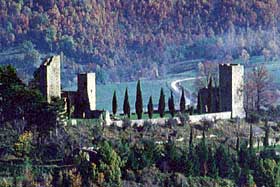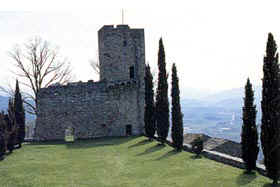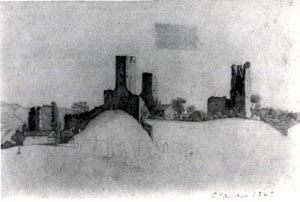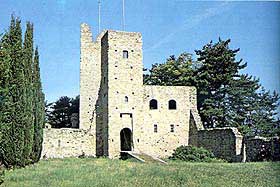Romena Castle
 |
 |
| Romena's skyline dominate the Casentino. | The Prison tower on the south side with a survived line of the inner walled enclosure. |
Driving from Florence to the Casentino on the SS.70 Umbro-Casentinese crossing the Consuma Pass we find Romena as a sentinel at the entrance of the valley. The castle is easily reachable thanks to road signals.
Around two kilometers southwest of Pratovecchio, on a hill of 621 meters high set on the right of the river Arno, rise the stately ruins of the famous Romena Castle. The castle still preserves notable signs of its past greatness and of the important historical facts that e interested it.
The traces of an human settlement on the hill are lost in the dark age, here have been found fragments of Etruscan vases of the the 3rd century B.C. and it seems that this area suffered a devastation at the passage of the army of Annibale directed toward Rome.
 |
1848 design performed by Ottaviano Goretti de' Flamini. |
Notices of the existence of a powerful and towered castle at Romena beginning from 1008. At the time it was the residence of the noble Count Guido Alberto of the Marquises of Spoleto, that from the year 1055 extended his dominion on the whole Casentino valley. Due to a series of marriages between nobles, had origin the dynasty of the counts of the Guidi family, that in the 12th century became the new owners of the castle. In 1217, after the death of the Count Guido Guerra, the patrimony of the Guidi was divided between their heirs and the castle was given to Aghinolfo, that originated the branch of the family known as of the 'counts Guidi from Romena'. In 1281 the castle was at the center of a particular episode of the medieval history: the falsification of some gold Florins of the Florentine Republic made by 'Mastro' Adamo da Brescia, on instigation of the counts Guidi, and the fact is also narrated by Dante in the Divine Comedy in the XXX° chant of the Inferno. During the years of the exile of the great Florentine poet (1301-1321) is almost certain that he, in good relationships with the Guidi, departed part of the same in the castle of Romena or however in its proximity's. The dominion of the counts on Romena terminated in the year 1357, when the castle was sold (for 9600 Florins) to the Commune of Florence. From historical sources we learn how great the power of the castle was at that time: around the inner enclosure and Keep the castle was endowed with 14 towers, triple walled curtains with residences for families and an hospital for the poor men and the pilgrims.
The castle was at the center of another important historical fact in 1440, when the troops of the Viscounts of Milan besieged and conquered Romena, provoking only few damages to the fortification. A little afterwards the fortification was regained by the Florentine and it remained in the Granduchy of Tuscany for the following centuries. In 1768 it passed to the counts Goretti de' Flamini, actual owners.
The most serious damages suffered by the construction are not owed to the war but to the nature: the earthquake that struck the zone in 1579 reduced the castle to a ruin. It's thanks to the work of the Count Ottaviano Goretti dé Flamini if this ruins came well preserved us. It was him that put end to the dismantlement of the towers and the remained walls carried on by some inhabitants of the zone that saw in the castle a comfortable cave of stones for building their residences and it's thanks to him that started a great work of restoration and maintenance for preserving this important piece of Tuscan history. Until the year 1889 farmer's houses rose attached to the second line walls and the grounds of the inner ward were cultivated. More damages to the construction were inflicted during the second world war, when it was object of allied bombardments against the German troops that were here barricaded.
 |
| North side: the tower of the Postierla with the drawbridge, the Palace of the Podesta and the Keep. |
Currently standing three towers and the mighty Keep, and parts of the three wall curtains. From north we find the rests of two gates, called 'Gioiosa' and 'Bacia', that allowed the entry to the inside enclosure of the fortification. From the tower of the 'postierla', with drawbridge and ditch restored during the last century, we enter inside the keep, where we find the so-called 'Palace of the Podesta' (medieval term for chief magistrate or governor), building residence of the counts, and the ' tower of the Mastio', the highest of the complex destined to the last defense. In the Keep we are still able to notice the presence of a beautiful cistern and an underground passage (today not agible) that conducted to the outside. Along the walls we can admire some brackets that supported the watch walk and the hoarding in timber, partly reconstructed. Important rests are those of the palace, inside its restored rooms we find a reconstruction in scale of the castle how it was at the time of its maximum shine. From the opposite side to the Keep, on the south front , crossed the whole inner ward we find the last of the three survived towers: the 'Prison tower' connected with the remnants of the inner walls curtain and still gifted with the brackets of the watch walk. Between the second and the first walled enclosure we found, always at south, the old Potesteria, restored currently and become farmer's house. Of the third walls line, the most external, remain traces along the slopes of the hill, in some points still endowed with battlements alternated by some towers, mainly on the southeast side. As said the castle is private ownership, but it is possible to enter asking the door-keeper that lives in one of the farmer's houses next to the entry.
| More Photos |
| Back to Homepage |
| Back to Castles Index |